
Web Developers
Company Overview
Price Technologies (Price) is a startup that is using machine learning and AI to build what it describes as the best matching technology in the world. The company’s vision is to become the “matching operating system” by matching anything with everything online. Price helps online retailers implement innovative product-matching technology applications such as visual and voice search. The company licenses its technology to some of the largest retailers and industry players in the world, which benefit from a new source of traffic, more relevant search results, additional engagement and increased retention. Price’s e-commerce application, Price.com, bridges the gaps among online marketplaces by providing consumers with complete transparency. Price.com is currently in beta mode and is expected to officially launch in early 2019. The technology can identify new, used, refurbished, unbranded and rental options for any item that is sold online that a consumer may be looking for. It provides users with complete price transparency and helps shoppers select the product that best suits their needs, while also helping them maximize their savings. Price.com leverages product-matching technology and data collected daily from more than 2,000 retail partners offering more than 150 million unique products. Through Price.com, Price offers retailers innovative matching technology applications, pricing strategies and catalog intelligence, including:- Innovative matching technology applications: Price helps online retailers implement innovative product-matching applications such as visual and voice search and browser extensions:
- The company’s visual search offering uses image recognition technology to enable shoppers to discover where a product they see in a photo (including on social media) can be purchased online, linking the image to relevant items on online marketplaces.
- Price helps retailers build voice search applications that match a shopper’s words or voice commands with relevant items on online marketplaces.
- Price’s white-label browser extension allows retailers to drive traffic from any site to their own site. It works via Chrome, Firefox and Safari, and across thousands of sites.
- The company’s white-label chatbot enables product matching through chat.
- Pricing strategies: Price.com helps guide shoppers’ decisions by providing suggested pricing and predictive pricing for the fair market value of any used product.
- Catalog intelligence: Price offers companies catalog normalization and automatic taxonomization capabilities.
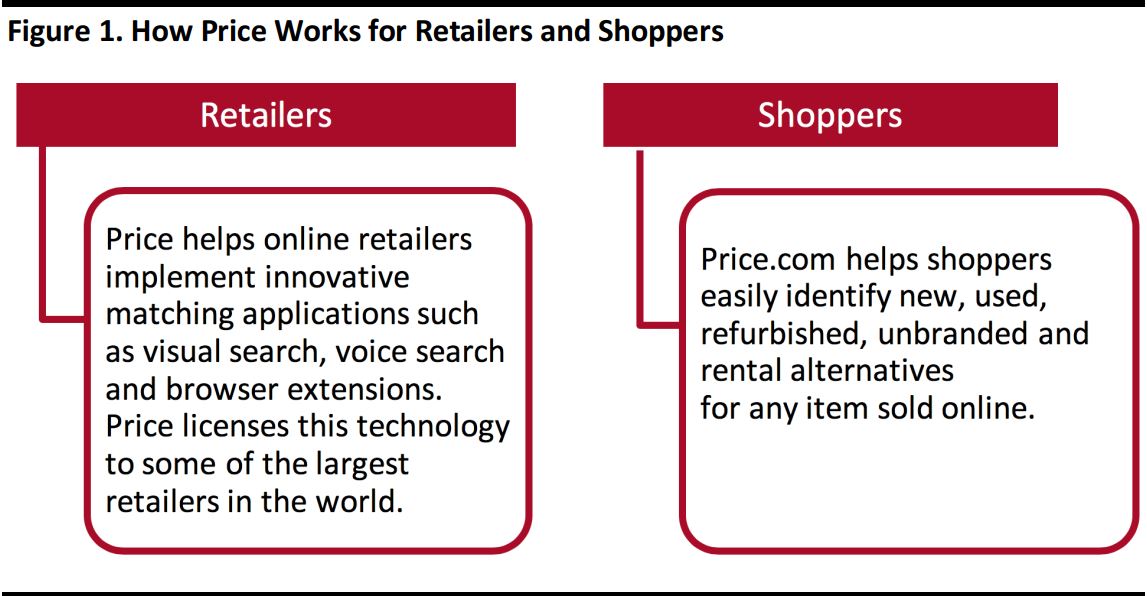 Source: Price Technologies/Coresight Research
Source: Price Technologies/Coresight Research
Price.com: Milestones
Price.com is the brainchild of computer scientist and tech entrepreneur RJ Jain, who says that he wanted to enable shoppers to see all the purchasing options available across online marketplaces in one place. Jain says that he conceived the idea after buying a dining room table one day and then finding the same item for less than half the price on a used product marketplace the next day. Jain developed Price.com to give shoppers a tool to avoid such costly but common mistakes.
Jain previously cofounded Appurify, a platform that solves the challenge mobile developers face when developing applications for multiple devices that use different operating systems. The company was later acquired by Google. Jain saw parallels between the fragmentation of operating systems across mobile devices and the fragmentation across online marketplaces. Price.com was designed to reduce that fragmentation by displaying all purchasing options to shoppers, increasing transparency and purchasing confidence.
Price was founded in 2016 and has raised a seed round of funding totaling $4 million. The company released Price.com in beta in 2017 and signed its first licensing contract in July 2018.
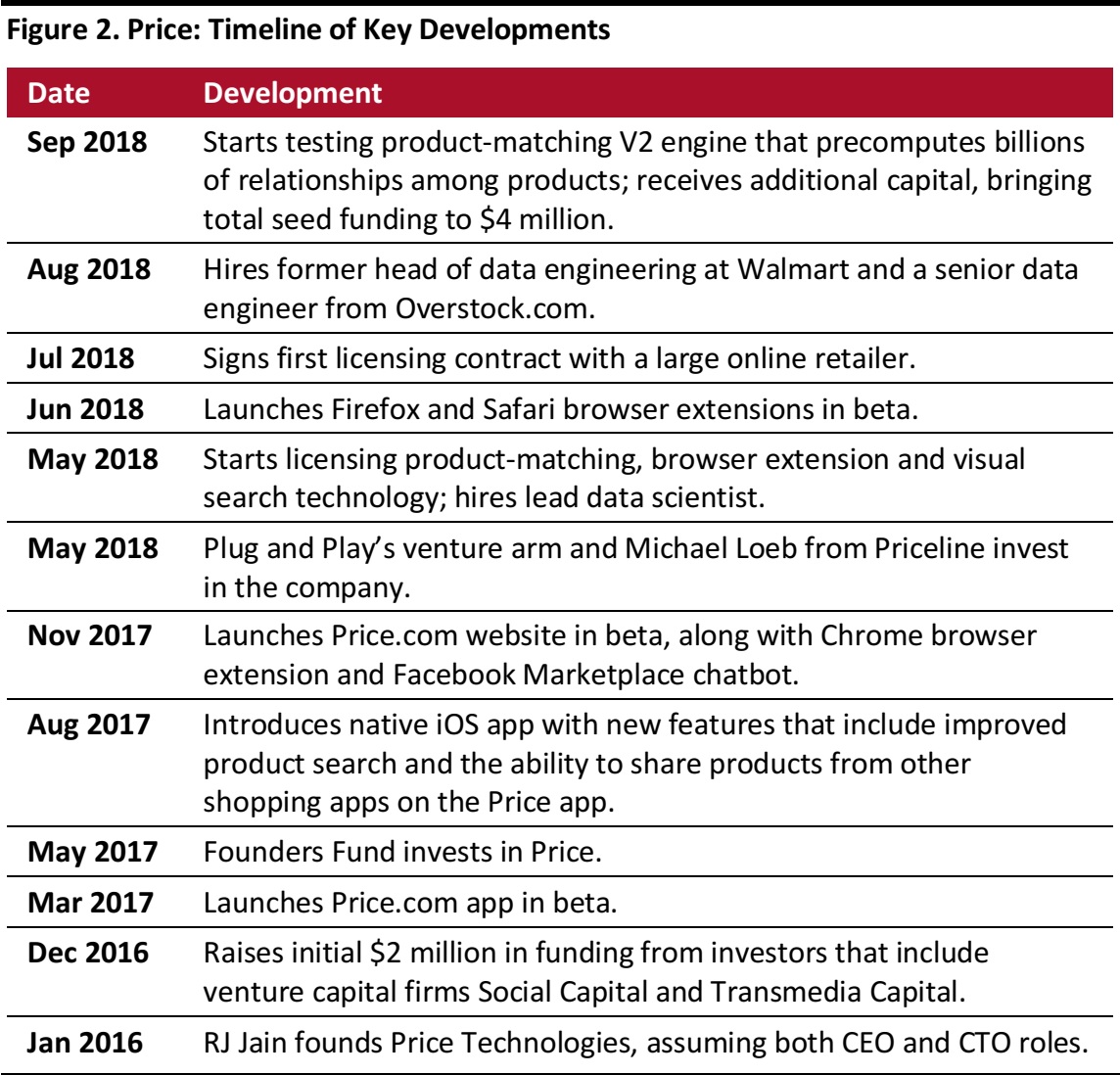 Source: Price Technologies
Source: Price Technologies
Company Offering
Price.com uses matching technology to provide consumers with transparency, enabling them to instantly shop across online marketplaces for any product they are looking for. Price.com shows all the marketplaces where the item is available for sale—whether new (such as on Amazon), used and available locally (for example, on Facebook Marketplace or Letgo) or refurbished—as well as sites where the item is available for rental (such as Rent the Runway or Fat Lama).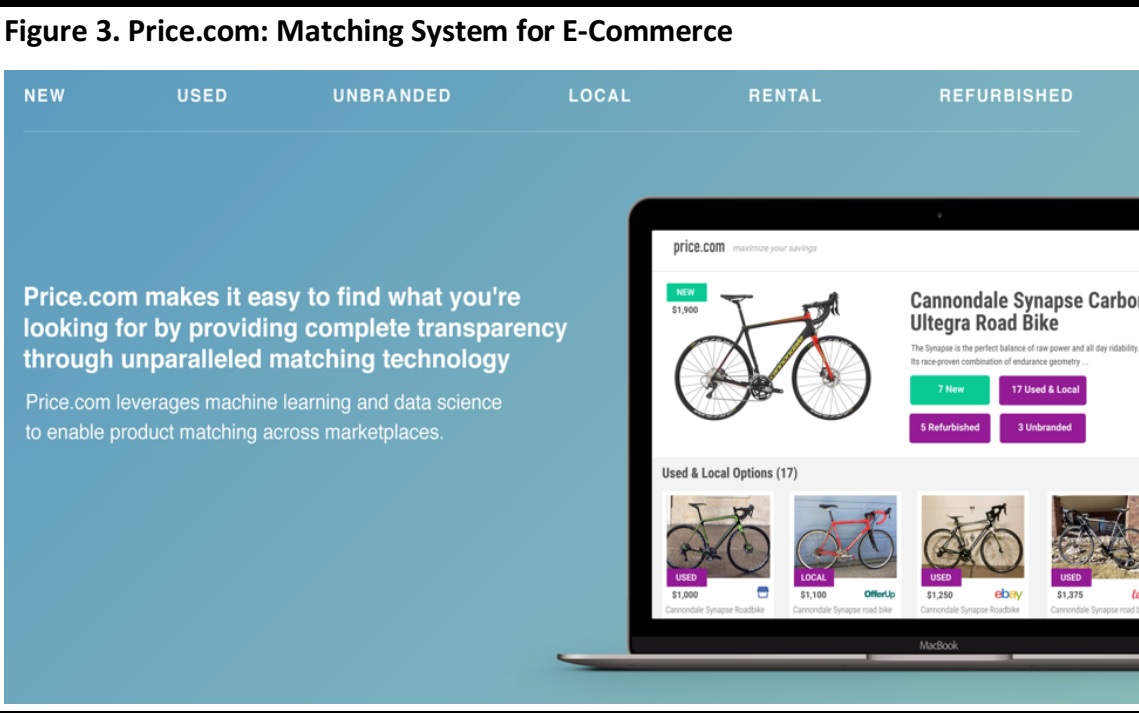 Source: Price Technologies
Source: Price Technologies
With one click, shoppers using Price.com can generate comprehensive search results that show purchase and rental options for a product. Shoppers can then choose from among the top marketplaces that offer new, used, unbranded and local products for sale or rent.
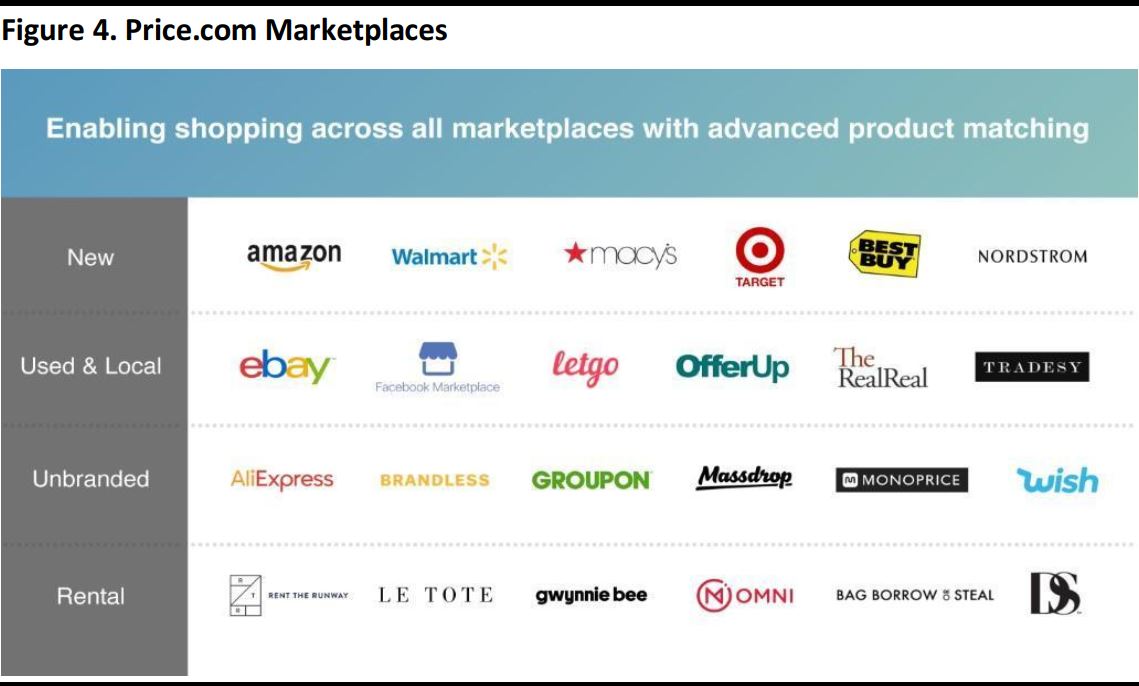 Source: Price Technologies
Source: Price Technologies
Shoppers can access Price.com via native app, browser extension, chatbot or website:
- iOS app: The Price.com app enables users to easily shop across all online marketplaces. To see a holistic view of all their shopping options, users simply search for a product, scan a barcode, take a picture with the app, or, while shopping on another app, share the product to the Price.com app.
- Browser extension: Once the browser extension is installed, shoppers can browse the websites of their favorite online retailers and marketplaces, then simply click a button on a product page to see all relevant product matches across all marketplaces.
- Chatbot: The Price.com chatbot integrates seamlessly with Facebook Messenger. Price describes its chatbot as “the world’s most comprehensive AI-powered shopping assistant.” Users can copy and paste the URL of an item they are interested in or upload a picture to the chatbot and instantaneously receive relevant matching results from all marketplaces.
- Website: Visitors to the Price.com website can search any product or URL, or upload a picture, to shop for the product across all marketplaces. Price also scans the Internet for products with the best reviews and provides users with a full view of all their shopping options for these top-reviewed products.
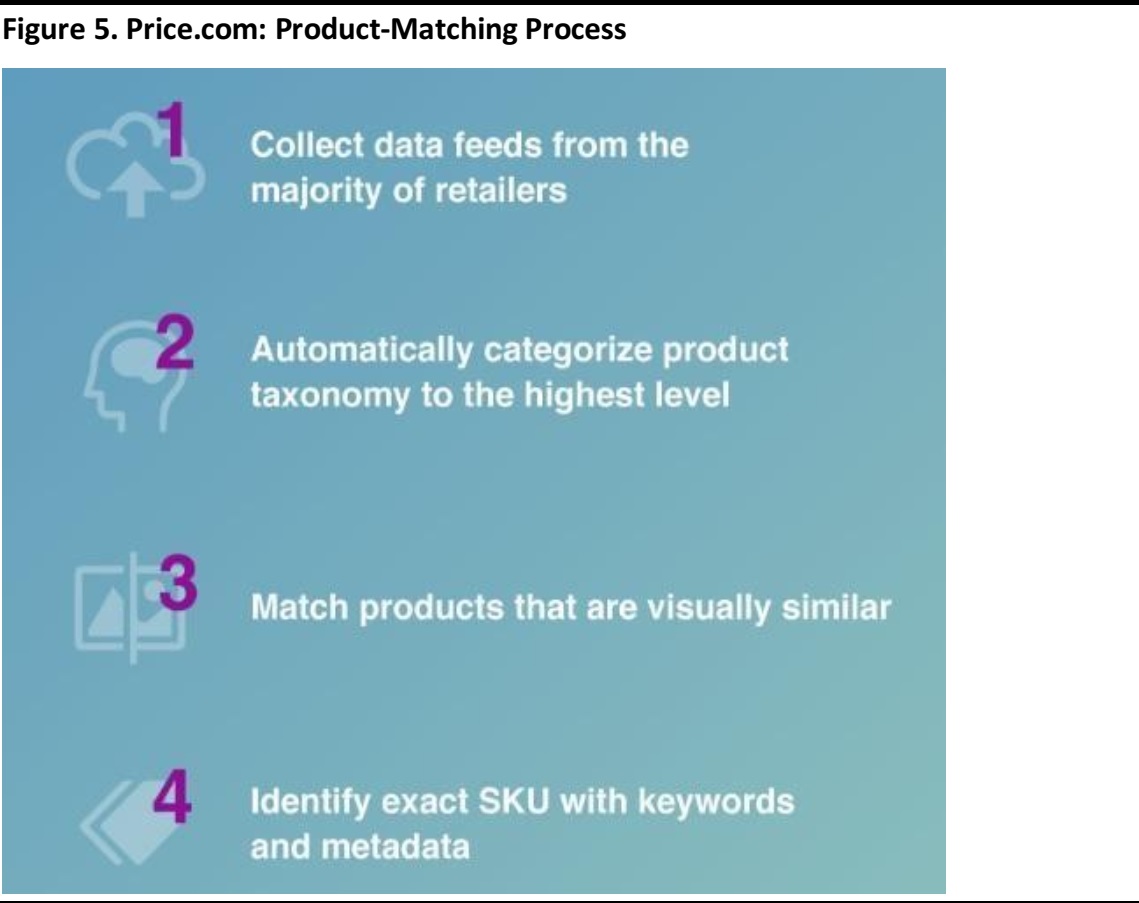 Source: Price Technologies
Source: Price Technologies
Price.com’s product categorization methodology enables shoppers to perform fast and accurate searches. One of the biggest challenges for e-commerce aggregators is that the marketplaces from which they pull product listings can define categories differently. To standardize categories across retailers and marketplaces, Price.com developed a universal taxonomy that is based on the different shopping taxonomies from Google and other retailers and that maps product titles using machine learning. Price.com also leverages AI, as well as its huge database of hundreds of millions of products, to correctly match currently available products across a range of independent marketplaces.
Price uses natural language processing to read and understand detailed product descriptions and extract the most relevant details, just the way a human might if she could read millions of descriptions at once. This enables the creation of an automated taxonomy of items, allowing the platform to provide shoppers with options for products that exactly match the one they searched for or are highly similar. For example, Price.com can provide a shopper who is searching for a couch from Wayfair with couches from Restoration Hardware that have the same product specifications.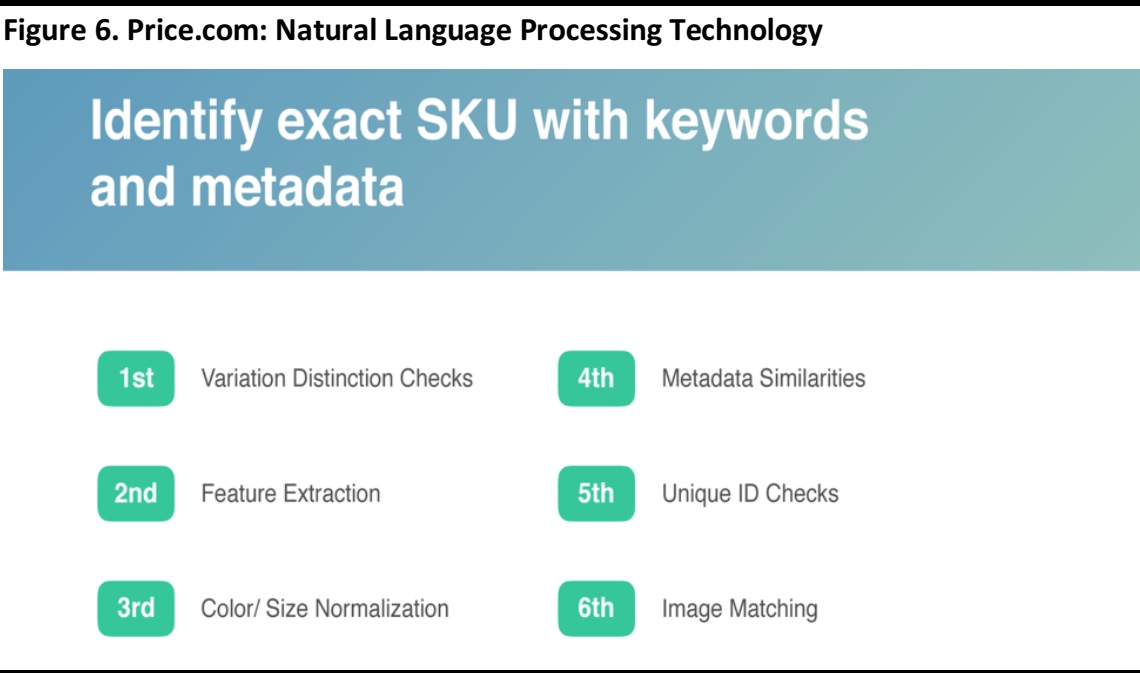 Source: Price Technologies
Price also uses advanced image analysis to find visually similar products. When a shopper sees a photo and thinks, “I’ve seen a bag that looks just like that one,” the technology can identify where she can buy or rent the product.
Source: Price Technologies
Price also uses advanced image analysis to find visually similar products. When a shopper sees a photo and thinks, “I’ve seen a bag that looks just like that one,” the technology can identify where she can buy or rent the product.
 Source: Price Technologies
Source: Price Technologies
By combining all the information, descriptions, images and standardized codes that are available, Price can correctly categorize products, compare identical items across shopping platforms, and find exact or similar products to meet a range of shopping needs.
Industry Overview
Price.com operates within the e-commerce industry, a large and dynamic sector that had a total global value of $1.4 trillion in 2017 and that is estimated to grow at a CAGR of 15% through 2022, to $2.8 trillion, according to Euromonitor International.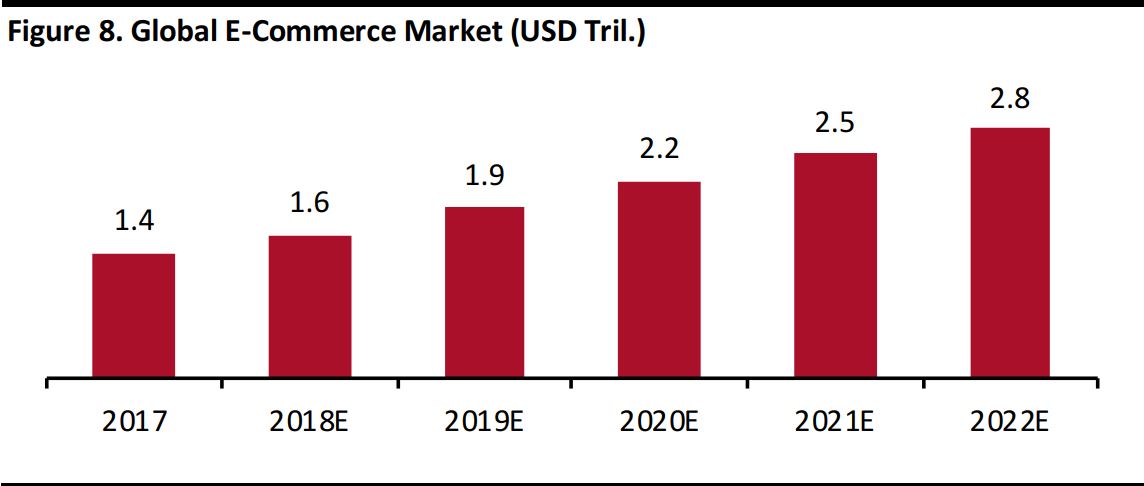 Source: Euromonitor International/Coresight Research
Source: Euromonitor International/Coresight Research
Marketplace sales—transactions between a third-party company or brand and consumers via an online platform such as Amazon or eBay—are increasingly driving e-commerce. According to Euromonitor, marketplace sales accounted for 41% of all online retail sales in 2017, up from 17% in 2008. Amazon and other major e-commerce retailers have begun relying more heavily on such sales. In 2007, third-party sellers accounted for only 26% of all units sold on Amazon, but that figure has risen to 53% today.
Within e-commerce, Price.com enables shoppers to browse for new, used and rental products on specialized marketplaces, which are evolving rapidly and seeing significant growth as shoppers’ behavior and preferences shift.
Re-Commerce
Re-commerce, which refers to online product resale, is a thriving segment, thanks to the emergence of mobile peer-to-peer platforms that offer innovative and easy-to-use features, including social media functionality. This evolution has shifted resale away from traditional thrift shops. Alternative marketplaces, such as re-commerce sites, are showing faster growth than retail overall. The figure below shows the projected growth of the broader apparel retail category versus apparel resale between 2017 and 2022. Source: Euromonitor International/ThredUP/Coresight Research
Source: Euromonitor International/ThredUP/Coresight Research
In its most innovative forms, re-commerce shows even stronger dynamism. For example, re-commerce disruptors—companies such as ThredUP, The RealReal and Poshmark—are growing 24 times faster than the broader apparel retail category, according to the ThredUP 2018 Resale Report. Within re-commerce, apparel is the largest category, and it will make up 49% of total US re-commerce sales in 2018, according to ThredUP estimates.
 Figures do not sum to 100% due to rounding.
Source: ThredUP/Coresight Research
Figures do not sum to 100% due to rounding.
Source: ThredUP/Coresight Research
Aside from the emergence of digital channels for buying secondhand items, several other factors have been contributing to the growth of re-commerce:
- Generational change: According to ThredUP, millennials and women over 65 are the two demographic groups most likely to shop for secondhand items.
- Greater interest from higher-income shoppers: Millionaires make up 13% of the most active shoppers on ThredUP, according to the company.
- Environmental concerns: Fully 77% of millennial consumers prefer environmentally conscious brands, according to ThredUP. Resale is seen by many as an antidote to the negative impacts that hyper consumption and disposable fashion have on the environment, as clothes that are resold are recycled rather than sent to landfills and none of the resources required to produce new merchandise are used.
- Value and cost savings: Some 66% of consumers say that they secondhand shop in order to buy more premium brands that they would not have bought otherwise at full price, according to ThredUP.
- Decluttering: The average American woman does not wear 70% of the items in her closet, according to ThredUP.
 Source: Allied Market Research/Coresight Research
Source: Allied Market Research/Coresight Research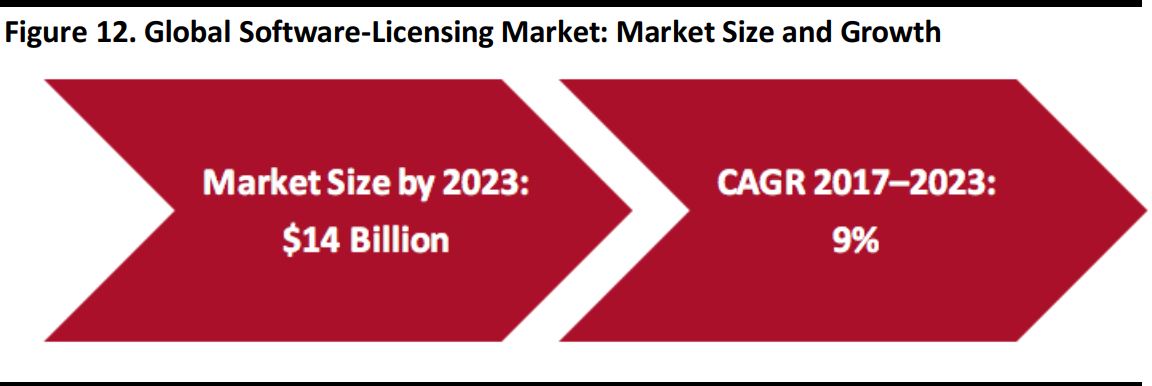 Source: Market Research Future/Coresight Research
Source: Market Research Future/Coresight Research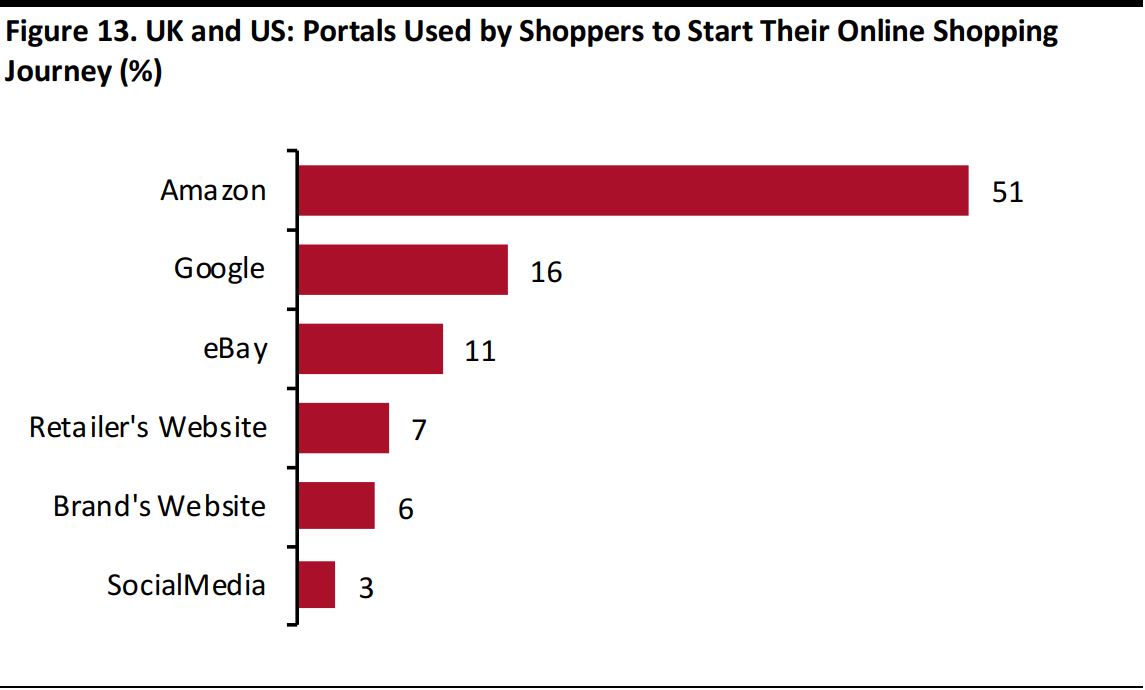 Source: Salmon/Censuswide
Source: Salmon/Censuswide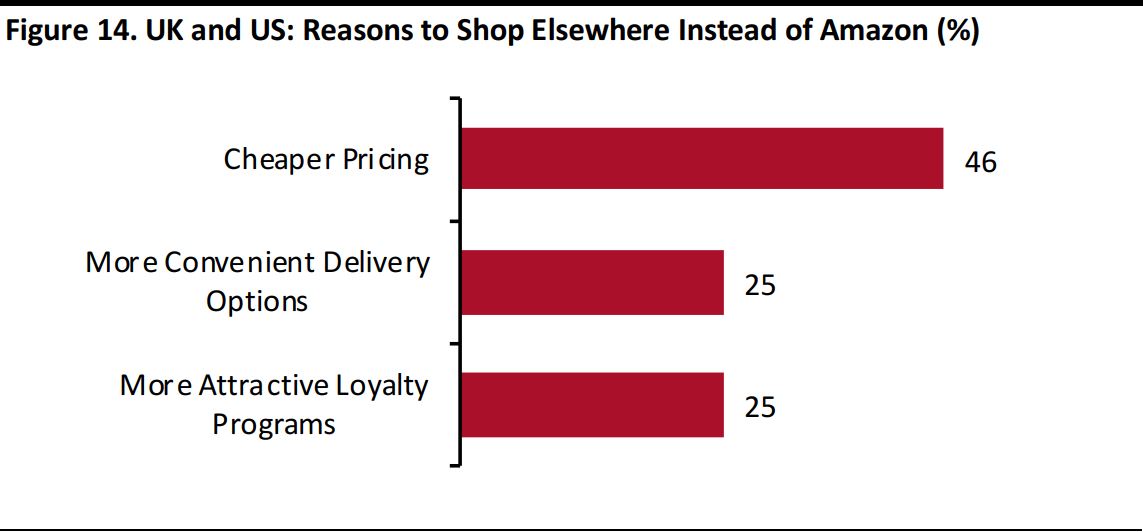 Source: Salmon/Censuswide
Source: Salmon/Censuswide Source: Coresight Research
Source: Coresight Research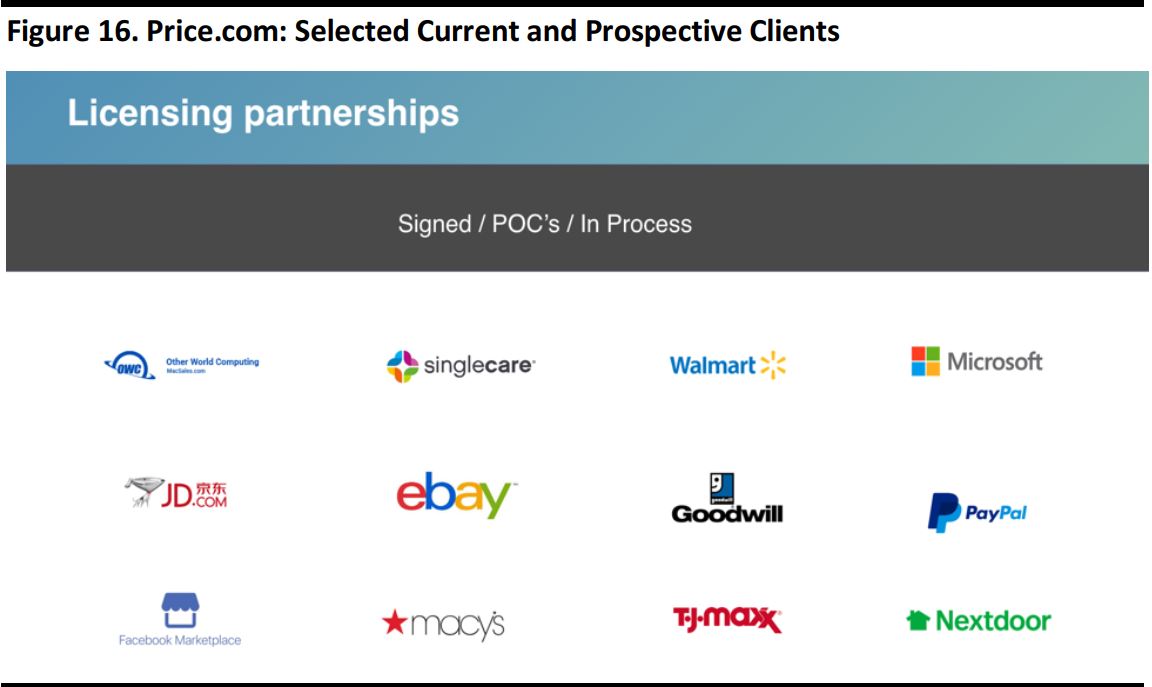 Source: Price Technologies
Source: Price Technologies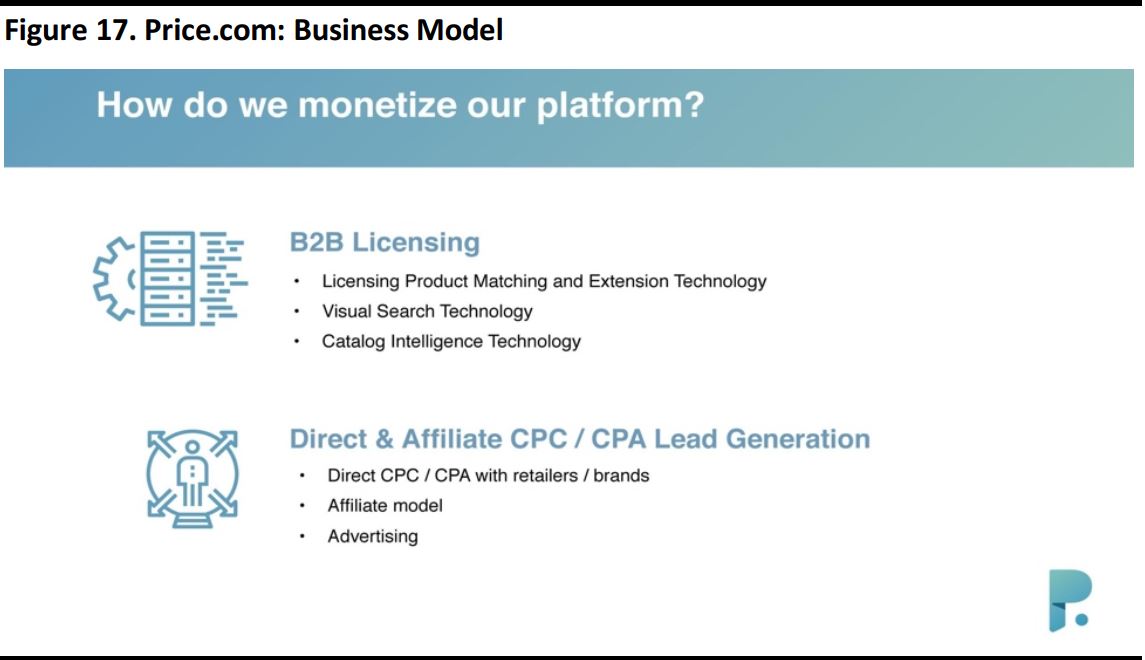 Source: Price Technologies
Source: Price Technologies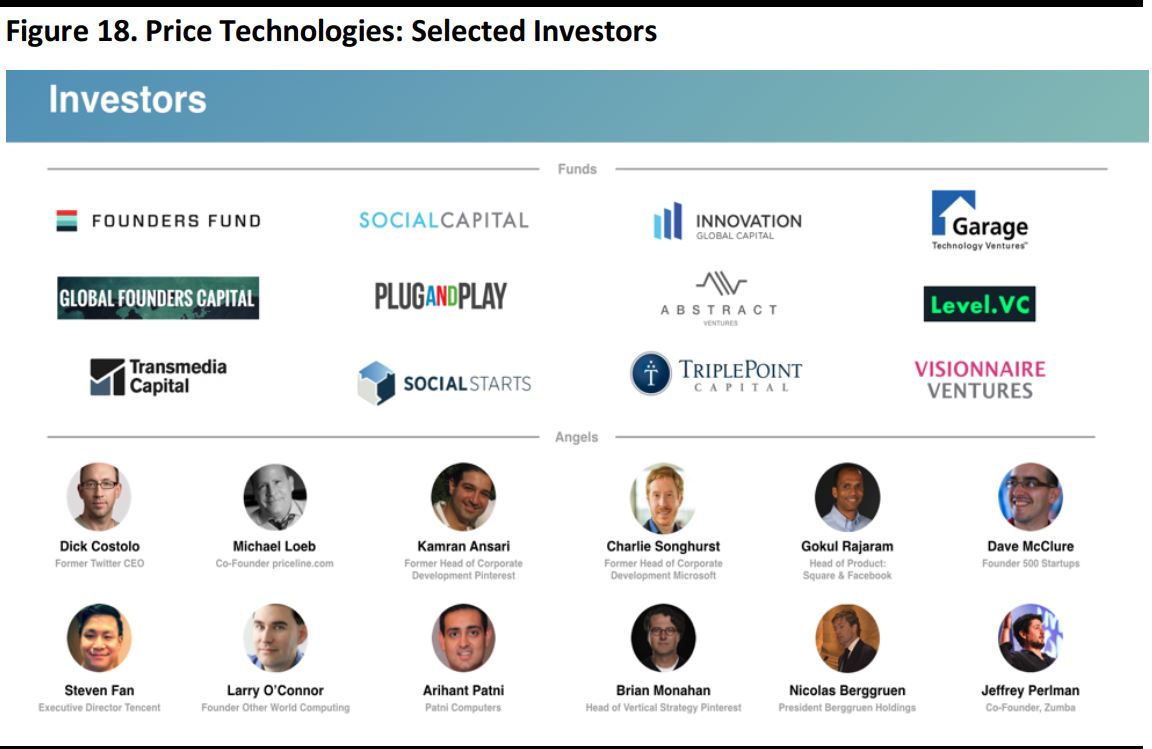 Source: Price Technologies
Source: Price Technologies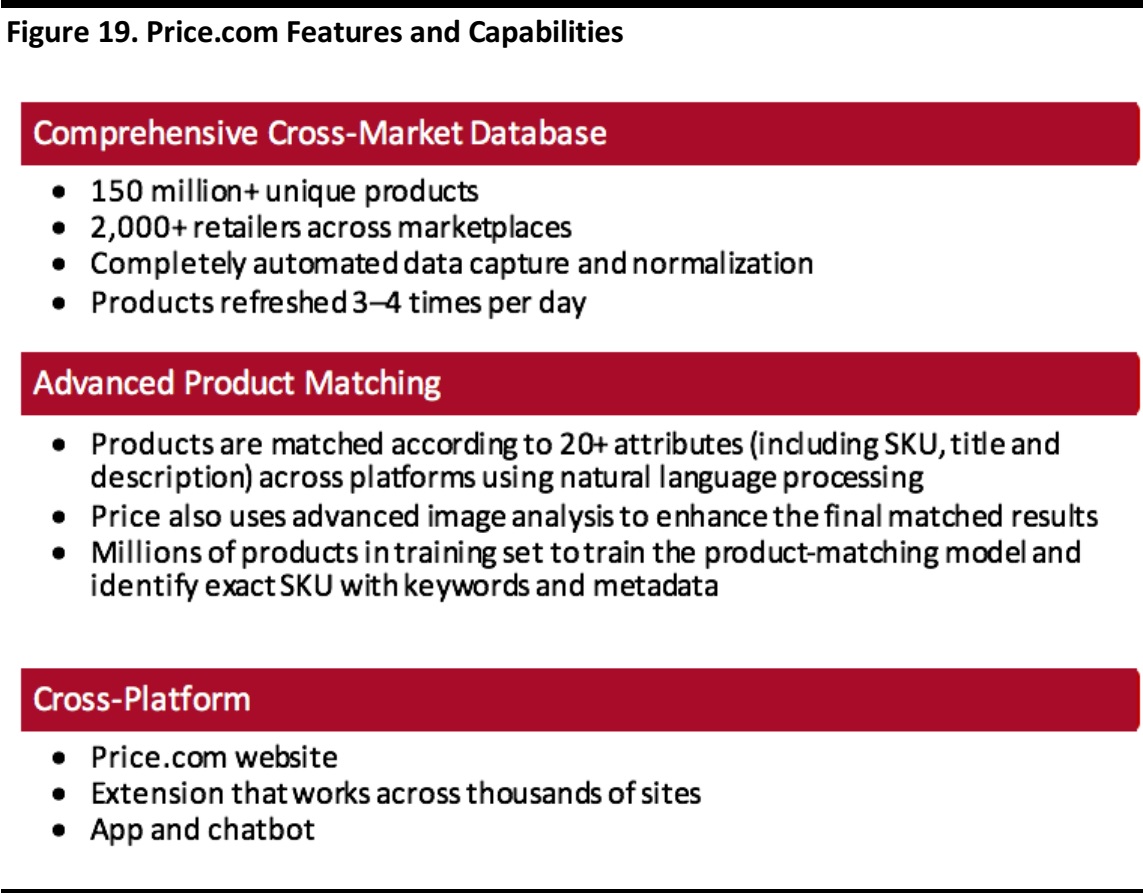 Source: Price Technologies/Coresight Research
Source: Price Technologies/Coresight Research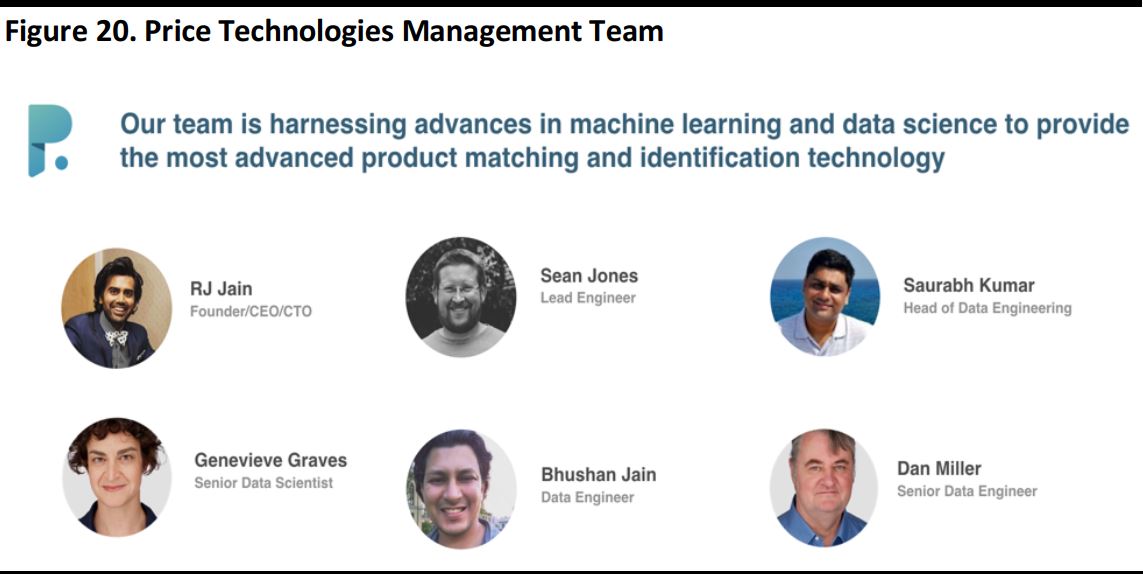 Source: Price Technologies
Source: Price Technologies